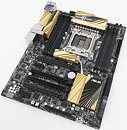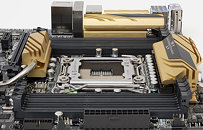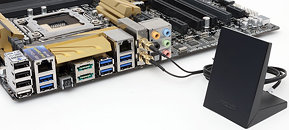Friday, September 6th 2013

ASUS Announces X79 Deluxe Socket LGA2011 Motherboard
ASUS announced its first socket LGA2011 motherboard after Intel's Core i7 "Ivy Bridge-E" family launch. Sticking to the simplified model naming scheme introduced by its LGA1150 motherboard lineup, the board is named X79-Deluxe, and is styled just like them (black PCB, black expansion-slots, gold heatsinks). It is expected to ship with out of the box support for Intel's latest HEDT chips. The board is built in the standard ATX form-factor, drawing power from a combination of 24-pin ATX and 8-pin EPS connectors. It uses a 10-phase VRM to power the CPU socket, which is wired to eight DDR3 DIMM slots, and four PCI-Express 3.0 x16 slots. A couple of PCI-Express 2.0 x1 slots, wired to the PCH, make for the rest of its expansion.
Storage connectivity includes eight internal SATA 6 Gb/s ports, of which just two are wired to the X79 PCH, four SATA 3 Gb/s ports, and two eSATA 6 Gb/s. Out of the eight USB 3.0 ports on this board, you get six on the rear panel, two by header. The X79 Deluxe features the latest WiFi GO! module by ASUS, which lends it 802.11 ac WLAN, and Bluetooth 4.0 support. Of the two gigabit Ethernet ports on the board, one is driven by an Intel-made controller. 8-channel HD audio, and a number of USB 2.0/1.1 ports make for the rest. Among the ASUS-exclusive features are USB BIOS Flashback, EPU, TPU II, ASUS SSD Caching, and USB 3.0 Boost. The X79 Deluxe from ASUS is expected to go for US $349.99. Find a comprehensive review at the source.
Source:
TechReport
Storage connectivity includes eight internal SATA 6 Gb/s ports, of which just two are wired to the X79 PCH, four SATA 3 Gb/s ports, and two eSATA 6 Gb/s. Out of the eight USB 3.0 ports on this board, you get six on the rear panel, two by header. The X79 Deluxe features the latest WiFi GO! module by ASUS, which lends it 802.11 ac WLAN, and Bluetooth 4.0 support. Of the two gigabit Ethernet ports on the board, one is driven by an Intel-made controller. 8-channel HD audio, and a number of USB 2.0/1.1 ports make for the rest. Among the ASUS-exclusive features are USB BIOS Flashback, EPU, TPU II, ASUS SSD Caching, and USB 3.0 Boost. The X79 Deluxe from ASUS is expected to go for US $349.99. Find a comprehensive review at the source.



24 Comments on ASUS Announces X79 Deluxe Socket LGA2011 Motherboard
I'll stick with my old Asus P9X79 Deluxe, although I really like the 12 SATA ports on the new X79 Deluxe and the feature set overall.
Isn't this a repackaged-Z87 including board? (You can see the blue intel sticker over at least 4 ports)
Anyway, i'm just about to get it so i'll surely know
None of this changes the fact that the X79 is an old chipset that was released back in late 2011. It is not a repackaged Z87 and I have no idea where that idea came from.
The X79 supports 4 SATA 3G ports and 2 SATA 6G ports. Therefore all other SATA ports are supported via 3rd party controllers.
No epeen features (ROG) yet loaded with useful stuff...
PD: Still flimsy USB3 onboard connectors?
Too bad an Asus rep didn't chime in and say:
"Good news everyone,....it also comes in blue with smell-o-vision outputs",...... ;)
Well I think it looks like a very nice board and the Marvell controllers are better than the ones on the P9X79. Still no native USB 3 though... bummer. :ohwell: Can't have everything. Grrrr... And now I want smell-o-vision! :shadedshu
First, its a cut-down compromised platform. Intel admitted that. SB-E didn't even have PCI-E 3.0 when the mainstream board did. Memory latency is 30% worse at the same speed making the platform feel unresponsive. Memory bandwidth is 30% better at the same speed on IVY or Haswell. I compared SB-E to a 3770K ivy platform and the ivy came out on top in many areas.
If you think its not normal to have more than 2 SSD's you're dreaming. Hello to a SSD boot drive and 2xSSD in RAID for storage. Not many people can afford a 1TB SSD for storage so a couple of smaller SSDs will do the job for cheaper. Or a lot of people RAID 2 SSDs for booting and have a third for storage. Most people need more than 2 sata 6GB/s ports. All SSDs are 6GB/s capable so 3GB/s ports are obsolete.
I need and want more than 2x Intel sata 6GB/s ports, and the native Intel USB 3 ports are better than third party., I don't want a board with a bunch of second-rate third party controllers that perform worse than Intel, like Marvell, and the point is, why pay more for a platform that does less, and uses double the power for sometimes worse performance. On the 4770K there are other Intel features too like quicksync. Most of the Z87 platforms come with the new ac wifi standard, have Bluetooth, and better audio etc. There are a bunch of good new features that don't come on the old X79 platform.
I tested both platforms in different areas, ivy was better in some areas, Sandy-e was better in others but not by much. Example, using the same graphics card (680 lightning) I got 10,400 3D marks on the sb-e. On ivy I got 10,250. So its almost the same but ivy uses half the power and 2 less cores. Many other tests like memory were better on IVY, sb-e was only better where the 2 extra cores come into play and that's not very often. Memory is rarely a bottleneck on modern platforms so any benefit of quad channel is lost by the extra latency.
With Haswell, the difference is even better. Intel themselves say you get "18% better everyday performance" on a 4770K than a $500 4960X. If you want to tell Intel they are wrong about their own products good for you but I believe them..There are not many apps that can use more than 4 cores, most of the tasks people do day to day are single core.
If you have a use for vt-d good for, I never said no one has a use for the platform, if you want to crossfire 3 or 4 graphics cards then yes you will need this platform, but for most people, you are much better off with a 4770K and a Z87 platform. That's my experience.
If you look around all the reputable websites, most experts agree that most people are better of with the mainstream platform because the highend sb-e/ivy-e just doesn't have the advantage it used to have over the mainstream platform. And in some cases its worse. This is the first highend platform that is worse in some areas than the mainstream platform, worse in performance and features and I'm not happy with it. Nothing will change my mind, I want Intel to do better with Haswell-e then I will re-assess.From someone who has used both platforms, trust me, get a 4770K and a nice Z87 motherboard. Some people have specific needs that might favour one platform over another but people like to justify their purchases too. There are many reviews around the net and all of them recommend the mainstream platform over ivy-e.
You can bash X79 and skt2011 as much as you want, but the simple fact remains that it doesn't appear that you knew what you were doing when you invested in skt2011. That's not a problem with the platform but rather your perception of it.
Just because your experience using skt2011 wasn't stellar doesn't mean that it's a bad platform or that you were even using it correctly for the right reasons. Now you can bash 2011 as much as you want, but the simple fact is that in real world performance, memory latency aside (which is less than you might think,) is that the difference between the 3770k, 4770k, and 3820 are pretty small and you should feel very little difference between the three. Someone who needs a 6-core has a goal in mind for it, and if your own goal is gaming, then you've missed the point.
Perhaps you are referring to the Asus P9X79 Deluxe?
I have an Asus P9X79 Deluxe motherboard and I find it to be an excellent solution.
To be perfectly honest, if you had an Asus P9X79 Deluxe and can't get the name of the board right when referring to it,....it kind makes everything else you have to say about the board a little suspect IMO,.....
Z87 also offers up to 6 SATA 6Gb ports.
Now here is the real kick in the balls, X79 and Z87 both use DMI 2.0 which only offers 20Gbit/s between the PCH and the CPU, so even if you could drive 6 SSDs that can saturate SATA 6Gb, you'll never realize it because DMI is a bottleneck, not to mention you slow down everything else that uses DMI (everything on the PCH, USB, Ethernet, eSATA, etc.)
So when push comes to shove, Z87 is newer but isn't really any more capable. It does use a little less power then X79 and offer a few newer features but not enough, in my personal opinion, to make a real difference. What my P9X79 Deluxe offers is pretty comparable to any decent 1150 board, with the exception of the things I mentioned earlier.
skt2011 is definitely one of those things where it only pays off to get it, if you need what it has to offer. Otherwise a mainstream board and CPU will be more than adequate.
Im not even going to bother with the rest of your rubbish. Your answer to less sata ports is to buy a raid card. So you're gonna pay more for the platform, then fork out more money just to get comparable features as a 1150 board. OK.
I've been buying the high end for years and YOU don't seem to understand that THIS IS THE FIRST HEDT PLATFORM THAT IS WORSE IN PERFORMANCE AND FEATURES THAN THE MAINSTREAM PLATFORM. When you go back to X58, X48, X38 etc, HEDT always had better performance and features than the mainstream platform. The HEDT platform before X79 was BETTER AT EVERYTHING INCLUDING GAMING. This is the first HEDT platform where Intel themselves advertise "18% worse performance than mainstream 4770K" This is the first HEDT platform that uses the same chipset as the previous generation.
Read the last paragraph again so you understand. Whatever your excuses are for socket 2011. It wasn't the case in the HISTORY OF INTEL HEDT platforms. If you still don't get it, don't bother me.
Anandtech review, (says exactly what I'm saying)
Although Haswell didn't break any records when it showed up on the desktop, there are definitely situations where it is clearly faster than even the fastest IVB-E SKU. Anything that doesn't make use of all six cores on a 4960X will likely be faster on a cheaper Haswell based 4770K. My guess is that this covers not only the overwhelming majority of the desktop market, but actually a good portion of the enthusiast desktop community as well.
The other downsides remain intact as well. Intel's X79 chipset remains very dated, even more so now that we have Z87 with Haswell. A fresh coat of paint and updated firmware isn't enough to hide the fact that you only get two 6Gbps SATA ports and no native USB 3.0 ports. All motherboard makers have worked around this by adding a plethora of 3rd party controllers to their motherboards, but I tend to prefer the native Intel solutions from a validation and compatibility standpoint. You also lose QuickSync support as there's no integrated GPU, although the two extra cores do help video transcoding go by a lot quicker.
In what I hope will be less than 22 months, Haswell E will likely fix many of these problems. Until that time comes, your decision is pretty simple. Ivy Bridge E picks up where Sandy Bridge E left off. If you have the money to spend and absolutely need any of the following:
1) More than 4 cores,
2) More than 4 DIMM slots,
3) More than 16 PCIe 3.0 lanes
...then Ivy Bridge E is your only option, and it's not a bad one at that. My biggest complaint about IVB-E isn't that it's bad; it's just that it could be so much more. With a modern chipset, an affordable 6-core variant (and/or a high-end 8-core option) and at least using a current gen architecture, this ultra high-end enthusiast platform could be very compelling. Unfortunately it's just not that today. I understand why (Xeon roadmaps and all), but it doesn't make me any happier about the situation. Instead we're left with the great option that is Haswell/Z87. If what you need falls outside of what Z87 can deliver then you're left with a decent, but very compromised (and pricey) alternative
Also Z87 still uses DMI 2.0, it has the same bottleneck between the CPU and the PCH as X79 had and with more SATA 6GB ports, you're only going to more quickly realize that bottleneck.
When it comes to the server market (which is what skt2011 falls under, weather you like it or not,) the PCH is a fall back or a starting point. It's never the end all decision because it's sub-optimal in terms of performance even more so when you start using RAID.
Clearly we're not going to see eye to eye on this, but your attitude (at least that I'm getting,) is that "Everything IVB-E can do, Haswell can do better," and my response has just been "Everything Haswell can do, IVB-E can do too."
At least as a platform skt2011 gives you options to upgrade, much more than 1150. It's not a matter of performance anymore when the last couple generations of CPUs have had very minor improvements.
A great example is those people still rocking X58 platforms. No reason to upgrade because there isn't a lot to be had, nor would it make a difference.
And there it is. Alas, I don't think I can go another year without a new motherboard before hell breaks out on the homefront. The server platform is still tempting and what I am accustomed to using with this old X58 which has served my needs very well and is still doing so as the family intranet junction. I need something to toss in that case sitting in my store room so I can boot this crate downline and my intellectually advanced daughters don't throttle eachother over my 6 year old's Spore game. The price of a Haswell processor is around that of the new IBE chip and it's starting to look like Haswell offers the best bang for the buck. The minimalist Z87 looks like something that belongs in the wife's non-existent PINK APEVIA. (One does well to consider domestic diplomacy.) So perhaps by the time Haswell E finally arrives I can flip the minimalist board into that pink abomination (which I have not yet purchased for obvious reasons) and finally put a real board in the coveted "not-so-virginal anymore" ThermalTake tower. At that point the 6 year old would be 8 and using the X58 for her gaming pc with that typical crazed gamer look on her face. Hopefully she won't drool. :rockout: Rock on!